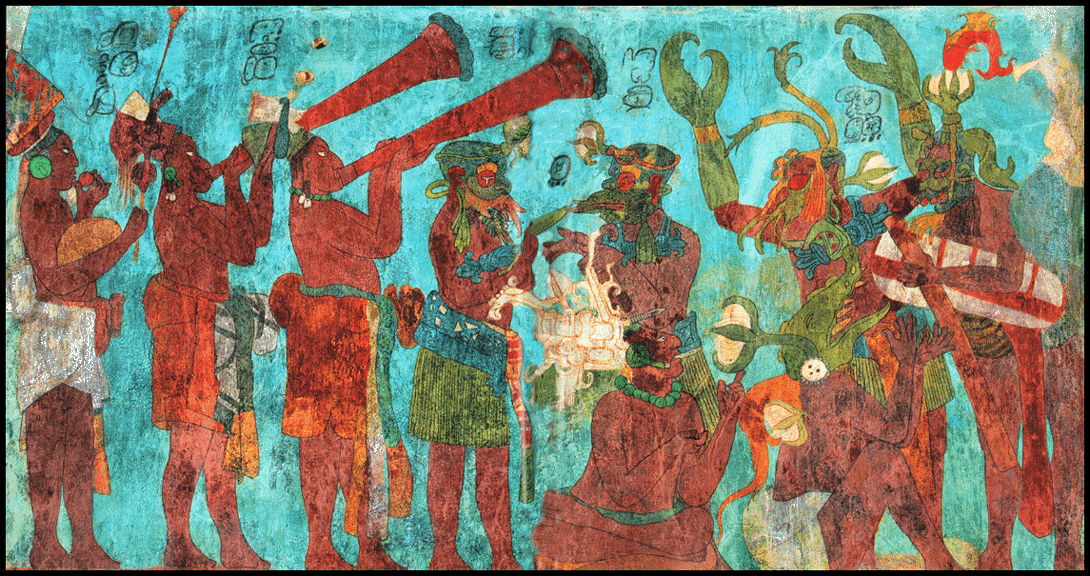
Pre-Columbian Maya music
Encyclopedia

Pre-Columbian
The pre-Columbian era incorporates all period subdivisions in the history and prehistory of the Americas before the appearance of significant European influences on the American continents, spanning the time of the original settlement in the Upper Paleolithic period to European colonization during...
Maya
Maya civilization
The Maya is a Mesoamerican civilization, noted for the only known fully developed written language of the pre-Columbian Americas, as well as for its art, architecture, and mathematical and astronomical systems. Initially established during the Pre-Classic period The Maya is a Mesoamerican...
culture still remains a bit of a mystery today. On the other hand, many aspects of Maya music have come to light from archaeological discoveries, ancient Maya murals, and ancient Maya texts. It is evident from these sources that music played a key role in the expressive arts of Maya culture. Music served many functions in Maya society, not to mention the role society played on music itself.
Functions of Maya music
It is believed that musicians served many ceremonial functions in ancient Maya culture. In various funeral ceremonies, it is believed that a procession of drum and flute players would follow the casket of important women, filling the air with a gloomy and natural tune. After the casket is laid, the musicians would then cast their instruments, breaking them in the tomb just before it is sealed.Music also filled the halls of Bonampak
Bonampak
Bonampak is an ancient Maya archaeological site in the Mexican state of Chiapas. The site is approximately south of the larger site of Yaxchilan, under which Bonampak was a dependency, and the border with Guatemala...
after victories of war. In the ancient murals of the Maya city, conch trumpet players are depicted playing for the leaders of their city after a successful campaign. In a display of skill and artisanship, the murals of Bonampak clearly illustrate that musicians, while servants of the city lords, were held in much higher regard than common townsfolk.
Common people in Maya culture did, as well, share interests in music. Archaeological finds have unearthed many unadorned drums and whistles in lower class housing. While it is unclear whether such instruments were reserved for ceremonial traditions, it is certain that simple drums and whistles filled many houses in ancient Maya territories.
The instruments
There were several classes of instruments in Maya culture: Percussion instruments of the Pre-Columbian era included mainly drums and maracas, mostly wood and occasionally tortoise shell. Archaeological evidence from the Pacbitun site also shows that sophisticated forms of maracas along with the small balls inside the hollow maracas were actually crafted in fired ceramic materials.In the same find, archaeologists discovered additional ceremonial flutes and ocarinas. Similarly crafted out of fired ceramic, the flutes and ocarinas of Pacbitun represent the most extravagant and unique collection of Maya instruments. While most flutes and ocarinas of their time consisted of bone, wood, or reed material, this unique collection sheds light on the important aspect of music in Maya culture. No remnants of pre-Columbian stringed instruments were found until archaeologists discovered a jar in Guatemala, attributed to the Maya of the Late Classic Era (600–900 CE), depicting a stringed musical instrument which has since been reproduced. This instrument is astonishing in at least two respects. First, it is the very few string instruments known in the Americas prior to the introduction of European musical instruments. Second, when played, it produces a sound virtually identical to a jaguar's growl.
Discography
- Ah-Kin. 1996. Children of the Moon. Ah-Kin Bonampak. Earthtone Records
- Berenholtz, Jim and Mazatl Galindo. 2004. The Land of the Feathered Serpent. Hu Ra.

